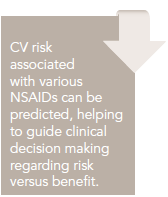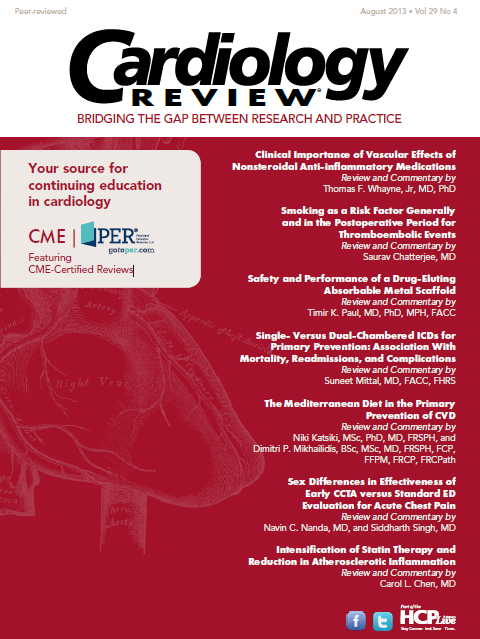Clinical Importance of Vascular Effects of Nonsteroidal Anti-inflammatory Medications
Thomas F. Whayne, Jr, MD, PhD
Review

Coxib and traditional NSAID Trialists’ (CNT) Collaboration. Vascular and upper gastrointestinal effects of non-steroidal anti-inflammatory drugs: meta-analyses of individual participant data from randomized trials [published online May 30, 2013. The Lancet. doi:10.1016/S0140-6736(13)60900-9.
Study Details
In their meta-analyses of individual participants from randomized trials, the Coxib and traditional NSAID Trialists’ (CNT) Collaboration performed a meta-analysis of 280 trials of nonsteroidal anti-inflammatory drugs (NSAIDs) versus placebo (124,513 participants, 68,342 person-years).1 They also analyzed 474 trials of 1 NSAID versus another NSAID (229,296 participants, 165,456 person-years).
The principal outcomes studied by the CNT Collaboration were: major cardiovascular (CV) events consisting of nonfatal myocardial infarction (MI), nonfatal stroke, or CV death; major coronary events consisting of nonfatal MI, or coronary death; stroke; mortality; heart failure; and upper gastrointestinal complications consisting of perforation, obstruction, or bleeding. Selective cyclo-oxygenase (COX)-2 inhibitors, also known as coxibs, were studied specifically; data, including individual participant data and aggregate data, were analyzed for the following coxibs: celecoxib, rofecoxib, etoricoxib, lumiracoxib, GW403681, and valdecoxib. The CNT Collaboration tried to use intention-to-treat analyses of first events during scheduled treatment periods, using adjudicated outcomes when available, although a few unadjudicated outcomes had to be used.
The specific CV findings of the CNT Collaboration were as follows1: major vascular events were increased approximately one-third by a coxib (rate ratio or relative risk [RR], 1.37; 95% confidence interval [CI], 1.14-1.66; P = 0.0009) or by diclofenac (RR, 1.41; 95% CI, 1.12-1.78; P = 0.0036), chiefly due to an increase in major coronary events. Ibuprofen also resulted in a significant increase in major coronary events but not major vascular events. As compared with placebo, for 1,000 patients taking a coxib or diclofenac for a year, there were 3 additional major vascular events, one of which was fatal. In contrast, naproxen did not cause a significant increase in major vascular events. Also, vascular death was increased significantly by coxibs and diclofenac, nonsignificantly by ibuprofen, and not increased by naproxen. Congestive heart failure risk was essentially doubled by all NSAIDs and, in addition, all NSAIDs increased upper gastrointestinal complications.
The clinical significance of the CNT Collaboration1 can be interpreted as showing that high doses of coxibs, diclofenac, and possibly ibuprofen are associated with a significant increase in CV risk, whereas high-dose naproxen has much less CV risk. The authors consider part of the value of their analysis to be that the level of CV risk with the various NSAIDs can be predicted. This prediction can then guide clinical decision making regarding risk versus benefit. Unfortunately, the meta-analysis of the CNT Collaboration does not break down CV risk differences among coxibs.
CommentaryIncreasing Awareness of a CV Problem With NSAIDs
The Coxib and traditional NSAID Trialists’ (CNT) Collaboration analysis1 adds further emphasis to an already wellestablished literature of published concerns regarding CV risk from use of NSAIDs. The concerns appear to have begun after the publication of studies of gastrointestinal toxicity of rofecoxib (Vioxx Gastrointestinal Outcomes Research [VIGOR] study)2 and celecoxib (Celecoxib Long-term Arthritis Safety Study [CLASS] trial).3 Mukherjee et al subsequently analyzed CV data from these studies and reported a surprising and unexpected association of increased risk for CV events.4 The results from VIGOR showed that the Relative Risk of developing a proven thrombotic CV event consisting of MI, unstable aging, cardiac thrombus, resuscitated cardiac arrest, sudden or unexplained death, ischemic stroke, and transient ischemic attack with rofecoxib compared with naproxen was 2.38 (95% CI, 1.39-4.00; P = 0.002). On the other hand, in CLASS,4 there was no significant difference in CV events (MI, stroke, and death) between celecoxib and the comparative NSAID medications (ibuprofen and diclofenac).3 The annualized MI rates for coxibs in both VIGOR and CLASS were significantly higher than the placebo group of an extensive meta-analysis of 23,407 patients in primary prevention trials (0.52%): 0.74% with rofecoxib (P = 0.04 compared with placebo in the meta-analysis), and 0.80% with celecoxib (P = 0.02 compared with placebo in the meta-analysis).4 It was such an analysis and data that led Mukherjee et al to evoke caution regarding CV risk and CV safety when coxibs are used.4,5
The need for a prospective, randomized evaluation of CV risk and safety of coxibs has been suggested4-6; any major such study appears yet to be accomplished. Such a trial may never be undertaken. In the case of rofecoxib, there appears to have been underreporting of CV events. Madigan et al analyzed 3 randomized placebo-controlled trials of rofecoxib versus placebo designed to test the possible role of rofecoxib in the prevention of Alzheimer disease.7 The published analyses of the 3 trials were restricted to on-treatment analyses that ended 14 days after treatment was stopped, and no CV risk was noted. However, when the authors did an intention-to-treat analysis, it was found that rofecoxib caused a significant increase in confirmed CV thrombotic deaths — nearly 40 months before the removal of rofecoxib from the market. In another meta-analysis, Varas-Lorenzo et al concluded that rofecoxib and diclofenac cause an increased risk of ischemic stroke.8 Specific CV problems associated with NSAIDs and coxibs are concern for prothrombotic risk, increased blood pressure, worsened hypertension control, and possibly causation of heart failure.9 García- Rodriguez et al, in a systematic review of randomized trials and observational studies, suggested that thrombi that develop with NSAID treatment may be different from spontaneous thrombi.10 These authors based this possibility on the fact that increased nonfatal MIs appeared to occur with both NSAID use and preexisting increased RR for CV disease, but there was no increased risk for fatal MI with NSAIDs in contrast to preexisting RR. There appear to be variations in different agents as in the CNT Collaboration, with naproxen clearly favored.1 Subsequent to various analyses, rofecoxib and valdecoxib were removed from the market in the mid-2000s.11
The evidence regarding the CV risk profile of coxibs, which appears to be mostly thromboembolic events, appears frequently to be derived from clinical trials as considered by Fosbol et al, whereas much of the information on traditional NSAIDs appears based on observational studies and meta-analyses.12 Fosbol et al comment on the different CV safety profiles that must be considered when selecting treatment. Diclofenac appears especially associated with increased CV mortality and morbidity, as was rofecoxib before removal from the market. Results with celecoxib appear intermediate, as in previous analyses of CLASS.3,4 In a review of the use of celecoxib for symptomatic relief of osteoarthritis, rheumatoid arthritis, and ankylosing spondylitis, McCormack comments that meta-analyses and database-derived analyses are inconsistent regarding CV risk.13 His assessment is that, at recommended dosages, the risk of increased thrombotic CV events and renovascular events with celecoxib is small, making it a useful option for therapy when there is a high risk for NSAID-induced gastrointestinal toxicity.
The question of other coxibs must also be considered regarding any unique place in CV risk. In a review of community-based controlled observational studies, McGettigan and Henry commented on sparse data for etoricoxib, but noted that in pairwise comparisons, it had a higher Relative Risk than naproxen or ibuprofen.14 In a meta-analysis, Mackenzie et al assessed CV outcomes between lumiracoxib and placebo or between lumiracoxib and other NSAIDs and found no significant difference, but commented that much further confirmatory research is needed.15 Nevertheless, at this point in time, celecoxib is the only available COX-2 or coxib available in the United States.
A key concept to remember when using a coxib and all NSAIDs regarding CV and renovascular risk is the administration of the lowest effective dose for the shortest possible duration.13 None of these medications can be considered safe in terms of CV risk but naproxen appears to be least harmful.16
References
1. Coxib and traditional NSAID Trialists’ (CNT) Collaboration. Vascular and upper gastrointestinal effects of non-steroidal anti-inflammatory drugs: meta-analyses of individual participant data from randomised trials [published online May 30, 2013]. The Lancet. doi:10.1016/S0140- 6736(13)60900-9.
2. Bombardier C, Laine L, Reicin A, et al. Comparison of upper gastrointestinal toxicity of rofecoxib and naproxen in patients with rheumatoid arthritis. VIGOR Study Group. NEJM. 2000;343:1520-1528.
3. Silverstein FE, Faich G, Goldstein JL, et al. Gastrointestinal toxicity with celecoxib vs nonsteroidal anti-inflammatory drugs for osteoarthritis and rheumatoid arthritis: the CLASS study: a randomized controlled trial. Celecoxib Long-term Arthritis Safety Study. JAMA. 2000;284:1247-1255.
4. Mukherjee D, Nissen SE, Topol EJ. Risk of cardiovascular events associated with selective COX-2 inhibitors. JAMA. 2001;286:954-959.
5. Mukherjee D, Topol EJ. Cox-2: where are we in 2003? cardiovascular risk and cox-2 inhibitors. Arthritis Research & Therapy. 2003;5:8-11.
6. Lipani J. Cox-2 inhibitors and cardiovascular risk: the data are inconclusive, and these drugs are needed. Cleveland Clin J Med. 2001;68:961-962.
7. Madigan D, Sigelman DW, Mayer JW, et al. Under-reporting of cardiovascular events in the rofecoxib Alzheimer disease studies. Am Heart J. 2012;164:186-193.
8. Varas-Lorenzo C, Riera-Guardia N, Calingaert B, et al. Stroke risk and NSAIDs: a systematic review of observational studies. Pharmacoepidemiol Drug Safety. 2011;20:1225-1236.
9. Mukherjee D. Nonsteroidal anti-inflammatory drugs and the heart: what is the danger? Congest Heart Fail. 2008;14:75-82.
10. Garcia Rodriguez LA, Gonzalez-Perez A, Bueno H, et al. NSAID use selectively increases the risk of non-fatal myocardial infarction: a systematic review of randomised trials and observational studies. PloS one. 2011;6:e16780.
11. Conaghan PG. A turbulent decade for NSAIDs: update on current concepts of classification, epidemiology, comparative efficacy, and toxicity. Rheumatol Internatl. 2012;32:1491-1502.
12. Fosbol EL, Kober L, Torp-Pedersen C, et al. Cardiovascular safety of non-steroidal anti-inflammatory drugs among healthy individuals. Expert Opin Drug Safety. 2010;9:893-903.
13. McCormack PL. Celecoxib: a review of its use for symptomatic relief in the treatment of osteoarthritis, rheumatoid arthritis and ankylosing spondylitis. Drugs. 2011;71:2457-2489.
14. McGettigan P, Henry D. Cardiovascular risk with non-steroidal antiinflammatory drugs: systematic review of population-based controlled observational studies. PLoS Med. 2011;8:e1001098.
15. Mackenzie IS, Wei L, Macdonald TM. Cardiovascular safety of lumiracoxib: a meta-analysis of randomised controlled trials in patients with osteoarthritis. Eur J Clin Pharmacol. 2013;69:133-141.
16. Trelle S, Reichenbach S, Wandel S, et al. Cardiovascular safety of non-steroidal anti-inflammatory drugs: network meta-analysis. Br Med J. 2011;342:c7086.
About the Author
Thomas F. Whayne, Jr, MD, PhD, is Professor of Internal Medicine in the Division of Cardiovascular Medicine of the Gill Heart Institute at the University of Kentucky in Lexington. He received his MD from the University of Pennsylvania in Philadelphia, and did his internship and residency at The New York Hospital-Cornell Medical Center in New York City. Dr. Whayne received cardiovascular training at the University of California in San Francisco and was also awarded a PhD in biochemistry from that institution. He was named to Who’s Who in America in 2003, to Who’s Who in the World in 2005, and to Best Doctors in America in 2009. He is fluent in Spanish and has authored numerous publications in both Spanish and English and has presented his work nationally and internationally.
